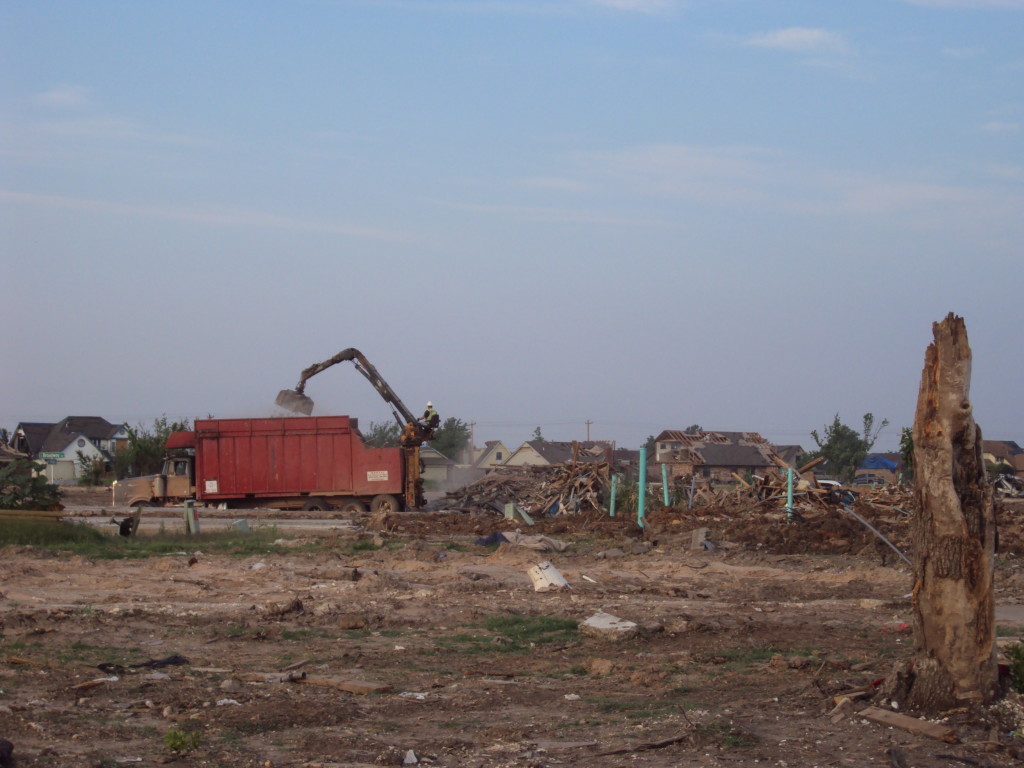
Kevin Bahner, PE
Principal
Kevin received his Bachelor of Science in Engineering with the Engineering/Pre-Architecture Option from the University of Oklahoma. He is a licensed Professional Engineer in Arkansas,…
View Profile
Growing up in Oklahoma City, you just get used to springtime weather warnings. Local news stations preempt your favorite shows or sporting events to shout about the next “outbreak”. They run commercials constantly, touting their army of storm chasers and daring weather choppers, beating their chest in the weather arms race. Then there are ever-present tornado sirens, going off like clockwork every Saturday at noon. Every Oklahoman has been within earshot of one as it sounds the alarm, radiating wails that have surely slipped into the subconscious of us lifelong residents. It is easy to see that we as ‘Okies’ could become callous to all of this, and even take it for granted. I know I did.
That all changed on May 20, 2013.
May 20 was different; it just happened so fast. The prognosticators had forewarned the potential for a large-scale outbreak of large tornadoes for days. I had been following the weather discussions online because you have to stay on top of these things. The storms fired up mid-afternoon just as predicted, and almost instantly they were spinning and bearing down on the OKC metro area. Watches quickly changed to warnings, and South OKC and my hometown were in the bull’s-eye. At 2 p.m., my wife texted that she was pulling our son from school as a precaution. I headed home 45 minutes later.
A tornado is imminent! By the time I reached home, the would-be monster was forming five miles away and heading right for us. Think! Can’t make it to the shelter at my parents, it would be driving right at the twister. Think fast! One look at my son in our closet with a hard hat on and I knew it was unsafe. Judging that we still had precious time, we drove away as fast as we could…while chaos ensued in our rearview mirror.
We were lucky. The massive twister spun up just west of my neighborhood, cutting a path of utter destruction within a half mile of our home. A close call, sure, but we were spared the damage and despair many of our friends and neighbors experienced.
Tuscaloosa and Joplin were just pictures and didn’t really hit home. I rushed to the scene right after the May 3, 1999 EF5, but I was still in college and just really didn’t comprehend the scale. Something like this takes on a different form when you have skin in the game – that could have been my home, could have been my son’s school. The what-ifs…you just can’t escape them.
I was fortunate my wife had the foresight to get our son from school early. As we drove away, we saw massive lines at his school (which, fortunately, was not hit) of frantic parents trying to get their children to safety. Their concern was warranted as many educational facilities do not have safe rooms or shelters to provide immediate refuge from tornadic events. The same scene was repeated at Briarwood and Plaza Tower elementary schools up to mere minutes before the tornado took them to the ground. At 3:16 p.m., only 20 minutes after forming, the storm struck Briarwood; three minutes later, it took Plaza Towers.
Time is literally of the essence.
Specifics of that day grow vague as time passes, but the wounds of the storm are still very much apparent. I see it every day on my drive to and from work, heading out to the grocery store, going pretty much anywhere in South OKC and Moore. Reminders are everywhere; the landscape littered with mountains of rubble as far as you can see. Homes, businesses, schools just gone. Giant mechanical claws toil away daily, slowly lifting the remains away in what seemingly will be an endless task. It’s been over a month, and they really have just started making a dent in the demolition and cleanup of the swath of destruction.
Being a structural engineer, seeing all this is quite disheartening. My job is to ensure the health, safety and welfare of the public when it comes to the design and construction of structures to withstand the elements of nature. But when faced with this, the indiscriminate power and fury of a large wedge tornado that I can see and feel, you really start to question how such a task can be accomplished.
The quote from the cover of the June 3, 2013 issue of Time magazine covering the Moore tornado really stuck with me: “16 Minutes. That’s how much time you have to save your life.” The speed at which the tornado went from formation to EF5 level winds was staggering. In my case, I pretty much geek out over weather so I was as prepared as anyone could be, but still only managed to get my family to assured safety with 15 or so minutes to spare.
Our schools are thought as safe havens for our youth, and they should be. Tornado drills are practiced routinely each spring, kids lining the hallways and interior classrooms, using desks or backpacks to protect themselves as best they can. But May 20 proved that plan is not foolproof; in fact, it’s far from it.
The only way to mitigate the risk of potential injuries and death is to have FEMA-rated shelters constructed on-site to house the school population. Shelters designed to meet FEMA P-361 standards and criteria provide near-absolute protection from extreme wind events. On-site shelters would eliminate the issue of short timeframes for reaction and give parents the peace of mind that their child is safe, even in the shadow of imminent danger.
I had noted earlier that designing structures to withstand EF5 level winds can a daunting task, but it is absolutely possible. I have participated in design of several FEMA rated shelter designs and, company-wide, Wallace Engineering has designed numerous shelters across the state. We engineers have the knowledge, analysis tools, and knowledge of construction types and techniques to provide the protection our youth and their educators deserve. These kids don’t need superheroes; they need us, as architects, engineers, contractors, and taxpayers, to be stewards of their well-being.
Certainly, there are huge hurdles to get past in order to provide shelters in all educational facilities, cost vs. razor-thin school budgets first and foremost. But the discussion of how we can make this happen should be on everyone’s agenda until we can make it a reality. There will be a financial burden to pay to provide this level of protection. But in light of the events of the May 20 tornado, the price is a small one to eliminate the worry and what-ifs, and to assure our children are safe.

Are you passionate about the AEC industry? Do you want to use your talents with a group of the greatest engineers, landscape architects, technicians and support personnel in the industry? You've found the right place. Wallace is unique in the way we strive to make lives better for our clients, communities and employees. And we believe we have more fun doing our job than just about anyone else! The art of possibility. Discover it at Wallace.
Learn More
Well written Kevin. Glad your family is safe! Sadly, it seems that a lot of schools try to “USE” the FEMA storm shelter grants to obtain new facilities such as a gymnasium (FEMA rated). We were short listed on such a project at a local school. I know it happens alot, but It seems to me that a structure like a gymnasium is not a cost effective solution for FEMA shelters…. the school was really trying to get a new gymnasium out of the deal, rather than really trying to make a safer place for their kids. The public needs to get serious about the actual problem.
My wife is a teacher and I asked one time where they were told to go during a tornado. It turns out the students line up against an unreinforced block wall about 10 feet tall that appears to be braced by THE ACOUSTIC CEILING?? Do we depend on the PE teacher turned principal to determine the safest place for our kids? I hope there is more to it than that. Sorry for the rant.